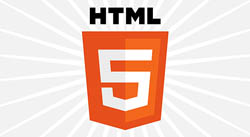Are CSS3 and HTML5 the "New Flash"?
Devs debate whether industry is failing to learn from past mistakes

In an article for Design Shack, Joshua Johnson asks: Are CSS3 and HTML5 the New Flash? He quotes some wisdom from the scientist in Jurassic Park — essentially, people get so preoccupied with what they can do, they don't stop to think whether they should — and notes that while CSS3, HTML5 and JavaScript have enabled "stunning new examples of astounding sites", there are problems ahead. Notably, Johnson is concerned that as some developers stretch nascent technologies to their limits, they "lose sight of what's permissible", leading to huge load times (including Flash-like 'loading' messages), sites becoming dependent on specific browsers, and complex animations causing browser crashes.
Johnson argues that he's not suggesting an end to experimentation, merely that designers and developers be a little cautious and ensure whatever they're creating increases the utility of a site and isn't just gloss for the sake of it. Clearleft developer Andy Hume isn't sure about the negative Flash comparison: "Regarding these standards becoming the 'new Flash', if we consider Flash to have been one of the most successful technologies for delivering rich, interactive interfaces in a web browser over the last ten years, then I very much hope so." However, he sides with Johnson regarding designers having the potential to 'abuse' technology: "Like any technologies, [CSS3 and HTML5] can be abused to do 'bad things'. Some Flash developers did this and in some circles this ended up giving Flash a bad name. It's nothing to do with the technology, but inappropriate use of that technology, which is the thing to worry about. There is a danger that people will forget what is permissible, and these people will build shit websites that nobody wants to use."
Hume's cohort, user experience designer Harry Brignull, is less anxious about the future: "When web designers gain a new way of creating rich interactive experiences, they usually get excited at first, experiment a lot, make mistakes, then learn from them and settle into using design patterns that work well for their target users." He says this is a "natural cycle of learning" we've seen before and that we'll see again.
Developer Thomas Fuchs thinks similarly. "People have always made bad websites, regardless of the technology used. This is like blaming guns for killing people — it's not the gun that pulls the trigger — it's what you make of it," he argues.
Fuchs adds that CSS3 and HTML5 do at least have one distinct advantage over Flash, regardless of how they are used: "They are openly developed standards, not a proprietary plug-in owned by one company. This, for many reasons, creates a much more solid base to work on." He reckons telling designers to be cautious is also the wrong way to go: "Designers should be bold and go out there and create amazing stuff with these new technologies."
Daily design news, reviews, how-tos and more, as picked by the editors.

The Creative Bloq team is made up of a group of art and design enthusiasts, and has changed and evolved since Creative Bloq began back in 2012. The current website team consists of eight full-time members of staff: Editor Georgia Coggan, Deputy Editor Rosie Hilder, Ecommerce Editor Beren Neale, Senior News Editor Daniel Piper, Editor, Digital Art and 3D Ian Dean, Tech Reviews Editor Erlingur Einarsson, Ecommerce Writer Beth Nicholls and Staff Writer Natalie Fear, as well as a roster of freelancers from around the world. The ImagineFX magazine team also pitch in, ensuring that content from leading digital art publication ImagineFX is represented on Creative Bloq.
